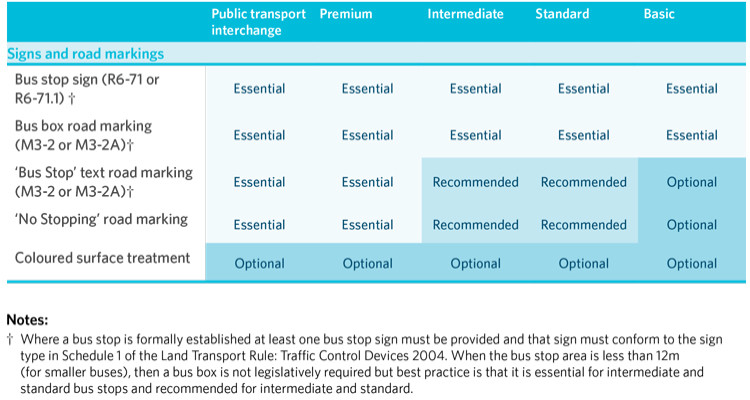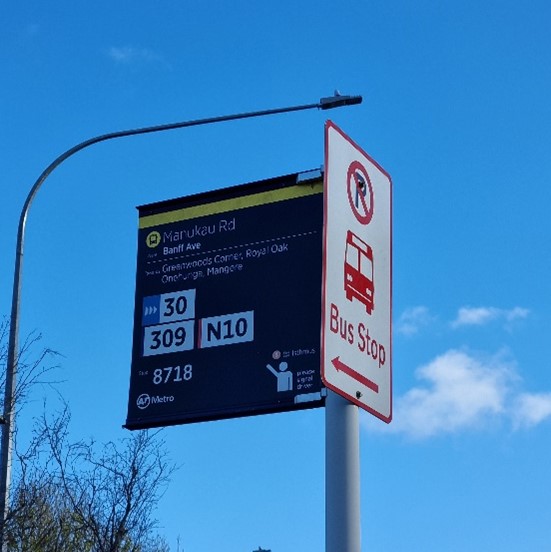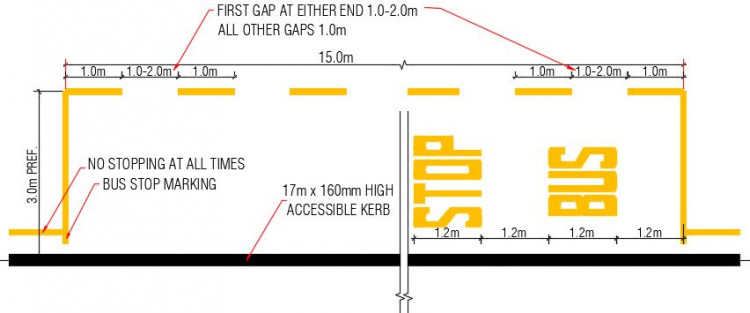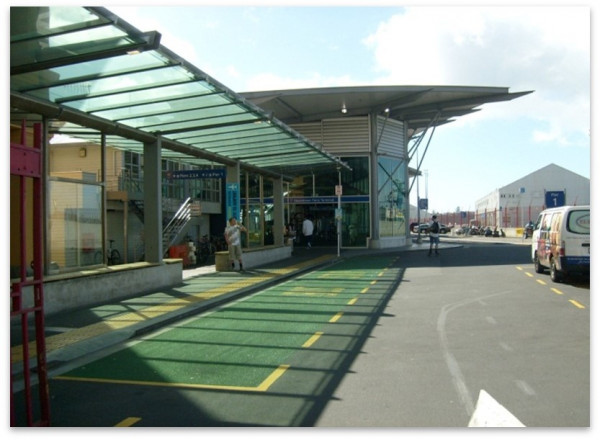Bus stop signs, number and type of bus stop signs, bus box road marking, bus stop roadway text, ‘No Stopping at All Times’ road marking, coloured surface treatment, summary of signs and markings by bus stop classification.
Land Transport (Road User) Rule 2004, clause 6.8 states that road users must not park, stand or stop on or within 6m of a bus stop sign.
Land Transport (Road User) Rule 2004, clause 6.8 (parking near bus stops)(external link)
Bus stops must be marked out where the space reserved for the bus extends more than 6m on either side of a single bus stop sign or when the bus stop is located in a parking zone.
The table below summarises signs and markings corresponding to each type of bus stop classification and whether the component is essential, recommended or optional.
Table: Summary of signs and markings by bus stop classification

Download signs and road markings table [PDF, 226 KB]
Where items marked essential are not legislative requirements, departures should be approved by the relevant road controlling authority and public transport authority.
Land Transport Rule: Traffic Control Devices 2004
A bus stop is a form of loading zone. Therefore, the bus stop sign is a form of regulatory parking/loading sign and consists of component parts in the same manner as other parking/loading signs.
Although there is a basic standard bus stop sign, the sign can have additional components such as arrows to show the extent and direction of the stop and the times when the stop operates (if not 24 hours a day). This means the standard bus stop sign (R6-71) can vary (for example, R6-71.1) as illustrated in the table below.
Table: Examples of bus stop sign types
| Sign reference |
Example |
Use |
|
R6-71 (bus stop standard) |

|
Establishes the presence of a bus stop and the parking restrictions associated with the sign. |
|
R6-71.1 (extent of bus stop) |
|
Establishes the presence of a bus stop and the parking restrictions associated with the sign. For use with long bus stops (more than 30m). Signs with left and right arrows are usually all that is necessary to define either end of the bus stop area. |
|
R6-71.1 variations (bus stop, specific days and times of operation) |

|
Establishes the presence of a bus stop and the parking restrictions associated with the sign and when the bus stop operates (if other than 24 hours a day). |
|
R6-71.1 variations (extent of bus stop and specific days and times of operation) |
|
Establishes the presence of a bus stop and the parking restrictions associated with the sign, the extent of the bus stop and when the bus stop operates (if other than 24 hours a day). |
For detailed sign specifications, see:
Sign specifications in the Traffic Control Device Manual
The bus stop sign identifies the space of roadway as a bus stop and prohibits parking in the space. It is also an important indicator to passengers, bus drivers and motorists and acts as a regulatory control point for the layout of bus stop facilities.
When a bus stop road marking is not present, the bus stop extends 6m either side of the bus stop sign.
When the bus stop sign is associated with a bus stop marking, then the sign should be positioned at the head of the bus stop, preferably on a standalone post in line with the head of the bus box. This allows for a consistent and predictable environment to be created at the bus stop. The sign should face the roadway, oriented parallel to the roadway, so it can be read by drivers pulling up next to it.
When a bus stop sign is installed, the presence of that sign defines the bus stop area. The bus stop length is 6m either side of the sign unless markings are present indicating a longer bus stop. Only a single bus stop sign is needed when the bus stop marking is present and extends up to and including 30m in length.
If the bus stop:
Ideally, the R6-71 or R6-71.1 sign should not be mounted on the existing poles. Where an additional supplementary sign is provided, it should be co-mounted on a bus stop–specific pole (see figure below). To mount the bus stop sign and/or the bus flag sign, the pole must be installed sufficiently far from the kerb so the sign achieves adequate clearance from the kerb (usually 1m) and achieves a clear walking path.
The final location of the bus stop sign should work with the surrounding location, but should be clearly visible to road users, be located near the front of the bus stop box and, ideally there should be some consistency in location across stops in a jurisdiction.

Bus stop sign (R6-71) with supplementary sign. (Source: Thomas Chu)
The bus box marking defines the outer perimeter of the road space dedicated to the bus stop. This helps create a consistent environment at the bus stop. Bus drivers know to stop their vehicle at the head of the box, which is where key infrastructure components are provided (for example, clear stand areas, tactile ground surface indicators, information and shelter). This is particularly important for disabled or vision-impaired passengers.
Where the road surface is suitable, bus stops should be marked on the section of road a road controlling authority has authorised to be reserved for a bus stop. Bus stop bays must be marked if they extend more than 6m on either side of a single bus stop sign.
Bus stop box markings must be marked in yellow and used in conjunction with those signs described above. Additional ‘BUS STOP’ words may be used if required, depending on the length of the reserved area (see bus stop roadway text below for more information).
The box marking consists of a 1m yellow bar marking that is 100mm wide. The gap between bar markings must be a minimum of 1m and up to a maximum of 2m for the first gap at either end. The range dimension in the gap marking is so the marking can be correctly laid out at certain bus box lengths (even number lengths).
Aim to create a visually consistent layout when varying the gap. We recommend varying the gap in only the first gaps at either end of the bus stop box marking. All other intermediate gaps should be 1m in length.
The bus box should be a minimum of 2.5m wide and preferably 3m wide.
It is best practice to mark a bus stop with the words ‘BUS STOP’ on the road surface as per the layouts illustrated in this guide (for example, the figure below). It is an important means of reinforcement to drivers and pedestrians that the space is used by bus services, so encourages compliance.
The marking ‘BUS STOP’ can be positioned and oriented in two different ways: parallel to the roadway (figure below) or perpendicular (as per Traffic Control Devices Rule, Schedule M3-2). Either text orientation is legal, but we recommend that in a city or region, the same orientation is implemented consistently.
Traffic Control Devices Rule, Schedule M3-2
The key dimensions of the bus box are shown in the figure below.

Typical bus box markings. View larger image [JPG, 44 KB]
The ‘No Stopping at All Times’ road marking consists of broken yellow lines. They are a mechanism to legally prohibit vehicles from obstructing the lead-in and lead-out of the bus stop, so the bus can approach and depart from the bus stop correctly.
For more information, see:
The profile of the bus box area may be raised further by highlighting the box with a coloured surface treatment. This makes the bus stop area more prominent to passengers and motorists. Although the treatment imposes additional costs, the raised profile of the stop may prove an effective deterrent to illegal parking and reduce enforcement problems at stops with a high potential for road user conflict (see the figure below).
The use of green surfacing has become associated with special vehicle lanes and, as a result, modes such buses. To maintain this association with public transport, coloured surfacing used at bus stops should be green.
For the colour specifications, see:
Technical Advice Note 17-18: P33 Specification for Coloured Pavement Surfacings

Bus box with coloured surface treatment, Auckland. Note: This stop does not appear to have adequate clearance. (Source: Auckland Transport)